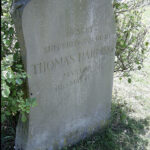
Thomas Harding
Date of Birth
1448
Place of Birth
Cambridge, City of Cambridge, Cambridgeshire, England
Towns / Cities Moved Into
Amersham, Chesham (both in Buckinghamshire, England)
Known Occupation
-
Religion
-
Spouse
Margaret Oswald
Death Information
Year of death
May 1532
Place of death
Chesham, Chiltern District, Buckinghamshire, England
Cause of death
Struck on the head by a spectator with a piece of firewood while waiting to be burnt at the stake as a Lollard
Burial location
Cenotaph erected in Saint Mary's Churchyard in Chesham, Buckinghamshire, England
Obituary

Parents

Roger Harding

Elizabeth Del’outhe
Marital Status


Married Margaret Oswald
1465
Cambridgeshire, England, United Kingdom
Siblings



Children



Narrative / Story
Thomas Harding’s life, spanning from 1448 to 1532, unfolds a narrative deeply entwined with the religious and socio-political fabric of 16th-century England. Born in Cambridge, Cambridgeshire, Harding’s early life was likely influenced by the academic and religious atmosphere of the city. His move to Amersham and later Chesham in Buckinghamshire marked significant chapters in his life, both personally and in terms of his religious beliefs.
In 1465, Harding’s life took a pivotal turn when he married Margaret Oswald. This union brought forth three children: Agnes Isabella, Joan, and Sir William FitzHarding. His family life, however, was overshadowed by the religious turmoil of the era. As a Lollard, Harding was part of a movement that sought religious reform, advocating for the translation of the Bible into English, a stance considered heretical by the Catholic Church.
Harding’s occupational life remains less documented, but as a resident of Amersham and Chesham, he might have been involved in agriculture or trade, common professions in these towns. His life in these towns was not just about work and family; it was significantly marked by his religious activities. He was known to participate in secret conventicles, meetings where Lollards gathered to discuss their faith and read the Bible in English, a practice forbidden by the Church.
The socio-economic landscape of England during Harding’s lifetime was one of transition and turmoil. The Lollardy movement, of which he was a part, was a precursor to the Protestant Reformation. This movement, while religious in nature, also had socio-economic implications, challenging the established Church’s authority and its role in society.
Harding’s steadfast commitment to his beliefs led to multiple trials for heresy. His final arrest in 1532, while reading William Tyndale’s “The Obedience of a Christian Man,” a work advocating for the translation of the Bible into English, marked the end of his journey. He was tried and convicted for his Lollard beliefs, which by then had begun to align with emerging Protestant views.
Tragically, Harding’s life ended in May 1532 in Chesham. While awaiting execution by burning at the stake, he was struck on the head by a spectator with a piece of firewood, resulting in his immediate death. His body was burned, and his ashes scattered, but his memory was honored with a cenotaph in Saint Mary’s Churchyard in Chesham, Buckinghamshire.
Thomas Harding’s story is a testament to the religious and socio-political upheavals of 16th-century England. His life, marked by personal conviction and the struggle for religious reform, reflects the broader narrative of a society in the throes of transformative change. His legacy, as a martyr and a symbol of the Lollard movement, continues to be remembered in the annals of English religious history.